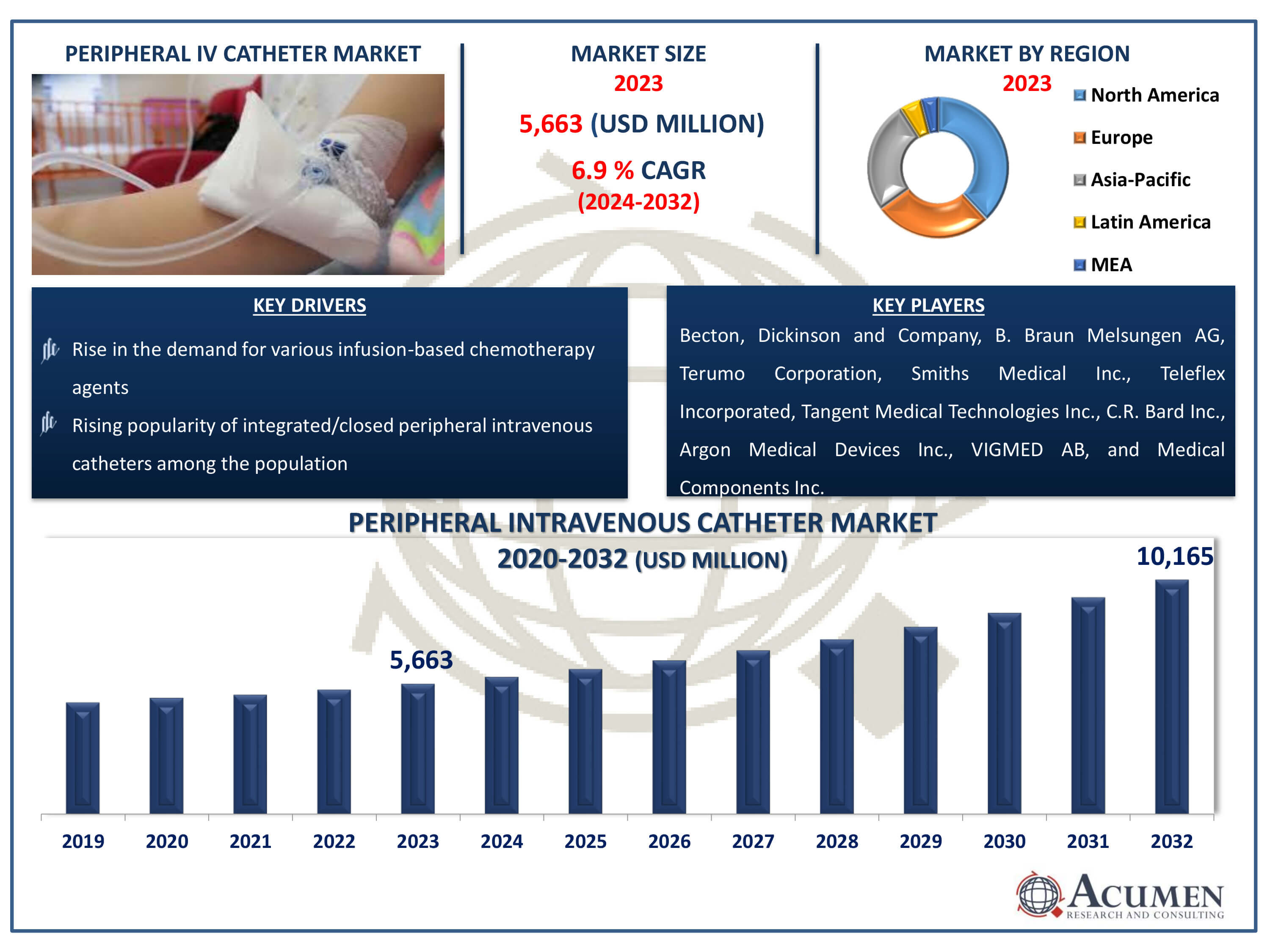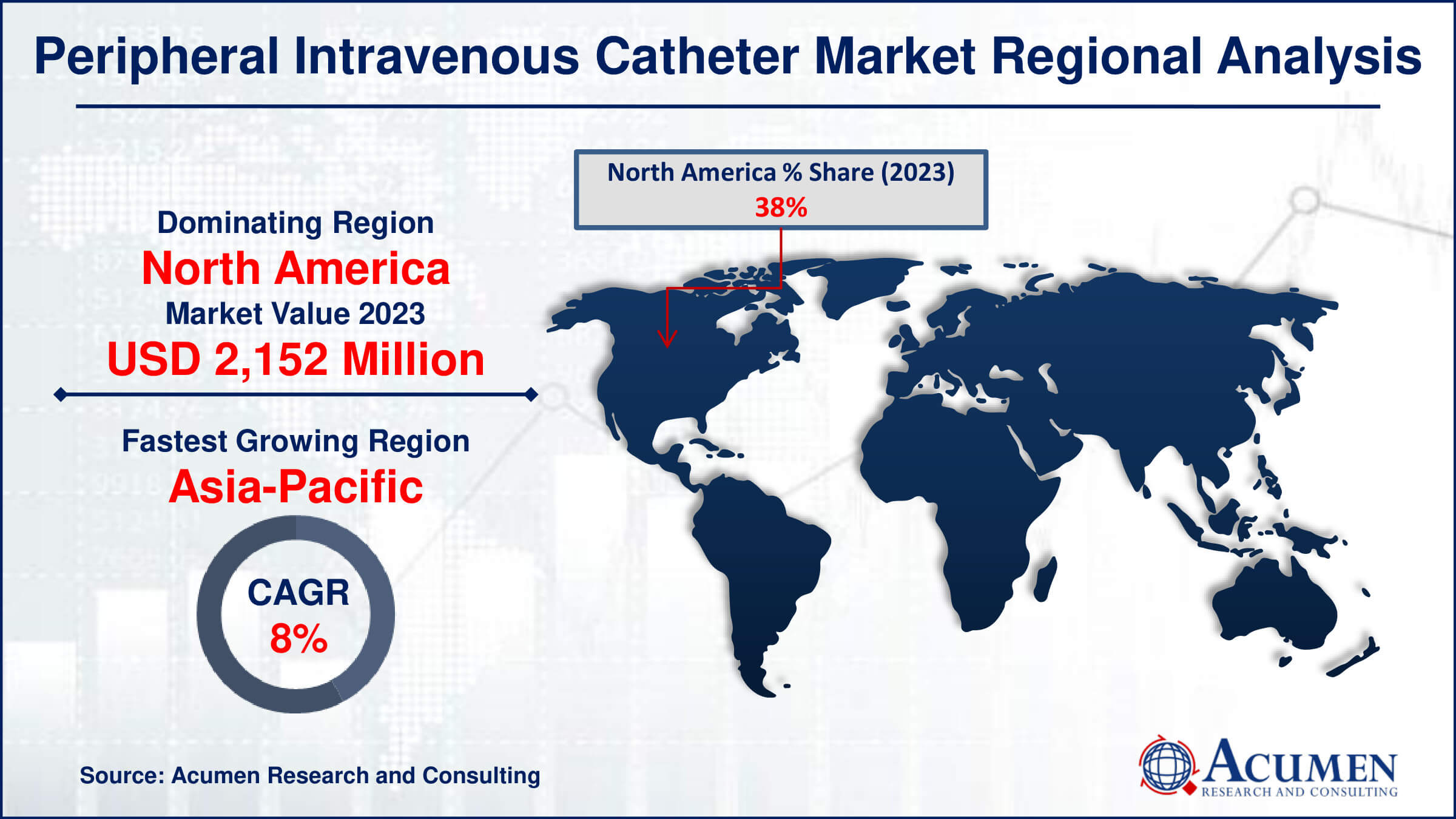July 2021
Peripheral Intravenous Catheter Market Size accounted for USD 5,663 Million in 2023 and is estimated to achieve a market size of USD 10,165 Million by 2032 growing at a CAGR of 6.9% from 2024 to 2032.
The Peripheral Intravenous Catheter Market Size accounted for USD 5,663 Million in 2023 and is estimated to achieve a market size of USD 10,165 Million by 2032 growing at a CAGR of 6.9% from 2024 to 2032.
Peripheral Intravenous Catheter Market Highlights

The peripheral intravenous catheter, often crafted from silicon and other biocompatible materials, minimizes side effects, allowing for extended use without adverse effects. These materials enable patients to retain the catheters in their veins for prolonged periods safely. Primarily, PIVCs are utilized for the direct infusion of medications and various fluids into a patient's vein. Enhanced peripheral intravenous catheters come equipped with advanced safety features designed to prevent needle stick injuries. The high incidence of needle stick injuries is driving medical professionals to adopt drug delivery systems that minimize this risk while enhancing patient comfort. Consequently, the growing awareness of needle stick injuries has spurred the adoption of safer and more secure devices, thereby expanding the market for peripheral intravenous catheters. Additionally, the increase in parenteral prescription medications being administered through these devices is expected to boost market transactions and, in turn, propel the market share of peripheral intravenous catheters.
Global Peripheral Intravenous Catheter Market Dynamics
Market Drivers
Market Restraints
Market Opportunities
Peripheral Intravenous Catheter Market Report Coverage
| Market | Peripheral Intravenous Catheter Market |
| Peripheral Intravenous Catheter Market Size 2022 | USD 5,663 Million |
| Peripheral Intravenous Catheter Market Forecast 2032 | USD 10,165 Million |
| Peripheral Intravenous Catheter Market CAGR During 2023 - 2032 | 6.9% |
| Peripheral Intravenous Catheter Market Analysis Period | 2020 - 2032 |
| Peripheral Intravenous Catheter Market Base Year |
2022 |
| Peripheral Intravenous Catheter Market Forecast Data | 2023 - 2032 |
| Segments Covered | By Product, By End-User, And By Geography |
| Regional Scope | North America, Europe, Asia Pacific, Latin America, and Middle East & Africa |
| Key Companies Profiled | Becton, Dickinson and Company, B. Braun Melsungen AG, Terumo Corporation, Smiths Medical Inc., Teleflex Incorporated, Tangent Medical Technologies Inc., C.R. Bard Inc., Argon Medical Devices Inc., VIGMED AB, and Medical Components Inc. |
| Report Coverage |
Market Trends, Drivers, Restraints, Competitive Analysis, Player Profiling, Covid-19 Analysis, Regulation Analysis |
Peripheral Intravenous Catheter Market Insights
The rising prevalence of acute and chronic diseases, along with a growing global population, is expected to lead to higher hospitalization rates, thereby driving the expansion of the peripheral intravenous (IV) catheters market. Additionally, an aging population and advancements in surgical and treatment technologies are resulting in more frequent surgical procedures, which further boost the demand for peripheral IV catheters. Increased disease incidence will elevate the need for catheterization across various healthcare settings, including hospitals, clinics, ambulatory surgical centers, and home healthcare. The rising intensity of epidemic diseases is anticipated to significantly increase the demand for PIVCs for consultations, diagnoses, and therapeutic interventions. Compared to other types of catheters, PIVCs are likely to see a higher adoption rate due to their versatility and ease of use.
Also, increased healthcare expenditure and ongoing changes to the healthcare system will boost the market value of peripheral IV catheters. Innovations in PIVC design and technology, such as safety features to avoid needlestick injuries and increased patient comfort, will drive market growth. The increasing ability of populations to pay costly medical treatments, such as catheter insertion, will continue to drive market expansion. However, the high cost of peripheral intravenous catheters poses a considerable barrier to commercial expansion. The cost of modern PIVC systems can limit their accessibility and use, especially in areas with low healthcare budgets or in developing nations where resources are sparse. This financial barrier may prevent healthcare facilities from widely adopting these devices, limiting overall market growth. Addressing this issue through cost-cutting techniques or increased affordability will be critical for the long-term growth and widespread adoption of PIVCs in the worldwide market.
Peripheral Intravenous Catheter Market Segmentation
The worldwide market for peripheral IV catheter market is split based on product, end-user, and geography.
Peripheral IV Catheter Market By Product
According to the peripheral intravenous catheter (PIVC) industry analysis, the short peripheral intravenous catheters (PIVCs) segment is expected to lead the market in 2023. A short PIVC is a small tube used to inject fluids or medications directly into a patient's vein, and it can also be used to draw blood. These catheters are made from soft, medical-grade materials like silicone or polyurethane, which do not irritate the skin.
The main reason for the growth of this segment is the rise in the number of hospitalized patients due to various health issues. The demand for short PIVCs increased significantly during the COVID-19 pandemic because more patients needed intravenous treatments and blood tests. Besides the pandemic, the growing number of people with chronic diseases such as diabetes, cancer, and cardiovascular disorders has led to higher use of short PIVCs.
These catheters are popular because they are easy to use, cause less discomfort, and reduce the risk of infection. Furthermore, advancements in catheter technology, including improvements in material strength and flexibility, have enhanced their safety and efficiency. As healthcare systems continue to advance and the global population ages, the need for short PIVCs is expected to keep rising. Additionally, the increased focus on improving patient care and the growing investments in healthcare infrastructure globally are further boosting the demand for short PIVCs.
Peripheral IV Catheter Market By End-Users
In terms of end users, the hospital segment is expected to create large revenues in the peripheral intravenous catheter (pivc) market, accounting for a sizable market share. Because of the large number of patients requiring intravenous therapies and treatments, hospitals are the most common users of PIVCs. Furthermore, the surge in hospital admissions, particularly during health crises such as the COVID-19 epidemic, has increased demand for PIVCs. Following closely, ambulatory surgery centers (ASCs) are likely to continue their position as the second-largest end-user segment, contributing significantly to overall market sales. ASCs regularly undertake outpatient operations and procedures, and PIVCs are commonly used to give drugs and fluids. The growing preference for outpatient treatments, driven by reasons such as convenience and cost-effectiveness, is likely to keep the demand for PIVCs in ASCs stable. Additionally, as global healthcare systems evolve, with a focus on outpatient care and minimally invasive procedures, the need for PIVCs in hospitals and ASCs is expected to rise steadily. This highlights the critical role that both the hospital and ASC segments play in driving the growth of the PIVC market.
Peripheral Intravenous (IV) Catheter Market Regional Outlook
North America
Europe
Asia-Pacific
Latin America
The Middle East & Africa

Peripheral Intravenous (IV) Catheter Market Regional Analysis
In terms of peripheral intravenous catheter market analysis, North America is expected to dominate the industry between 2024 and 2032, owing mostly to the region's rising prevalence of chronic diseases. The rise in demand for injectable pharmaceuticals, combined with a growing senior population and increased healthcare spending, strengthens North America's market leading position.
Asia Pacific emerges as the fastest-growing throughout the peripheral intravenous catheter market forecast period, driven by the rapid growth of the senior population and ongoing technology improvements. Countries like as China, India, and Japan are benefiting from expanding healthcare infrastructure and increased acceptance of innovative medical technology, which contribute considerably to the region's rapid market expansion. Simultaneously, Europe is expected to witness extraordinary growth, driven by higher hospitalization rates and strong economic conditions. The area benefits from the presence of key market participants that are actively pushing demand for peripheral IV catheters.
Peripheral Intravenous Catheter Market Players
Some of the top peripheral intravenous catheter companies offered in our report includes Becton, Dickinson and Company, B. Braun Melsungen AG, Terumo Corporation, Smiths Medical Inc., Teleflex Incorporated, Tangent Medical Technologies Inc., C.R. Bard Inc., Argon Medical Devices Inc., VIGMED AB, and Medical Components Inc.
Looking for discounts, bulk pricing, or custom solutions? Contact us today at sales@acumenresearchandconsulting.com
July 2021
November 2022
November 2023
January 2025